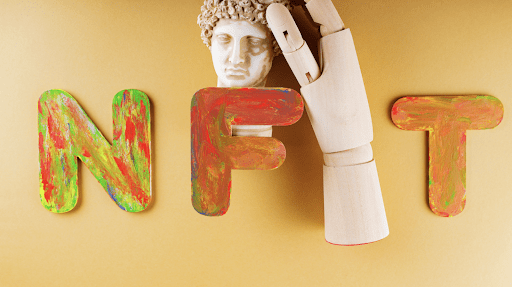
The popularity of non-fungible tokens (NFTs) is exploding. As more consumers, blockchain startups, and traditional businesses embrace the „decade’s phenomena,“ demand for adding additional utilities to these digital assets has expanded significantly.
Although the market capitalization of NFTs has surpassed the billion dollar barrier, with total 2021 sales exceeding $20 billion, NFTs continue to have little utility. While NFT marketplaces such as OpenSea, Rarible, and others enable users to buy, sell, and trade NFTs, there is little else to do. For example, if a user want to generate additional revenue through their NFT, they will be unable to do so because none of the existing platforms support this functionality.
How to Generate Passive Yield using your dormant NFTs?
The majority of DeFi products and services are not applicable to NFTs. There are few sites that offer loans secured by NFTs. Additionally, the majority of NFTs remain dormant in users‘ wallets due to the lack of viable choices for staking or lending.
To address this gap and enhance the value proposition of NFTs, Drops has built a proprietary mechanism that enables users to produce yields from otherwise inactive tokens. This end-to-end platform for loan underwriting against NFT and DeFi assets enables access to capital and income generation on these valuable but utility-limited assets.
Promising Alternative To Ethereum-Based NFT Marketplaces
Without intermediaries or complexities, Drops enables anybody to experience the entire power of NFTs. The platform makes use of lending pools that allow for the collateralization of any type of asset – from NFT collectibles and metaverse products to financial NFTs and DeFi tokens.
Cost-wise, Ethereum-based NFT marketplaces have already met a brick wall. When it comes to gas fees, minting, purchasing, selling, and even transferring an NFT are all prohibitively expensive on any Ethereum-based platform. In some instances, the gas fee is greater than the overall value of the NFT. This has resulted in a precipitous decline in popularity, owing to the fact that the majority of NFT marketplaces are built on Ethereum.
Drops eliminates Ethereum’s poor transaction speeds and expensive gas expenses by utilizing the layer-2 scaling solution Polygon. Simultaneously, the network leverages Biconomy’s dApp technology, which enables it to subsidize all transaction fees while allowing users to interact with the platform in the same way they would on the Ethereum mainnet. In essence, Drops combines the advantages of Polygon’s scaling and low costs with the security and user-friendliness of Ethereum.
Improving the Value Proposition of NFTs By Adding More Utility
Drops increases the usability of NFTs and addresses the liquidity crisis in DeFi by providing multi-chain loans for NFT and DeFi assets. Drops‘ two distinguishing features over existing NFT platforms are I the ability to convert NFTs into fungible ERC-20 tokens supported by permissionless liquidity pools, and (ii) the ability to borrow liquidity provider (LP) tokens and stake them for extra tokens.
Drops enables you to borrow against your DeFi tokens and NFTs that are sitting idle in your digital wallet. As long as you have NFT or DeFi tokens that may be used as collateral, you will be eligible for an instant trustless loan without having to interact with a lender or wait for approval.
Apart from that, Drops has introduced an enhanced liquidity platform known as Drops DAO, which is based on the permissionless Drops Loans protocol. Additionally, Drops enables you to maximize your portfolio’s returns by giving stable currencies and governance tokens to the platform’s permissionless lending pools in exchange for lucrative returns. Users that contribute liquidity using supported coins can earn variable returns and borrow from the pools.
Drops continues to advance through the product roadmap through numerous partnerships and expansion. The platform just integrated Chainlink Price Feeds into their Ethereum mainnet, allowing for precise and safe loan pricing against a variety of stablecoins and cryptocurrencies. Additionally, the company teamed with Enjin to enable users to stake and borrow ERC-20 tokens against NFTs or in-game assets via Enjin’s platform, rather than through traditional banks or lending products such as credit cards. Additional notable collaborations include those with Polygon, Oraichain, Parsiq, Solv Protocol, and the Blockchain Gaming Alliance (BGA).
The platform is compatible with a wide variety of NFTs, including financial, gaming, and collectibles. Drops is backed by leading venture capital firms and investors, including AU21 Capital, Axia8 Ventures, Bitscale Capital, Genblock Capital, x21, Quantstamp CEO Richard Ma, Sushi CTO Joseph Delong, Defiprime & DEXGuru CEO Nick Sawinyh, Cooper Turley of Audius, and Marc Weinstein of Mechanism Capital.
As the NFT ecosystem continues to grow, the Drops platform is a welcome addition. It gives value to NFTs that would otherwise collect dust, enabling it to establish itself as the first NFT-focused initiative to successfully bridge the NFT and DeFi ecosystems. Drops has the potential to outperform other peer-to-peer lending protocols such as NFTfi and Stater due to its permissionless lending and borrowing capabilities.
The author’s thoughts and opinions are entirely his or her own and do not necessarily reflect those of CoinNewsDaily. Each investing and trading action entails risk; before making a decision, you should conduct your own research.






















